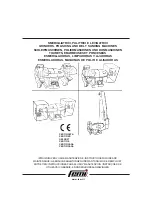
[17]
guard can result in injury due to wheel
breakage and wheel contact.
See the
Accessories Chart
for more information.
1)
Install the unthreaded inner flange on
spindle with the raised section (pilot)
facing the wheel as shown.
2)
Place wheel against the inner flange,
centering the wheel on the raised
section (pilot) of the inner flange.
3)
While depressing the spindle lock
button and with the hex depressions
facing away from the wheel, thread the
outer flange (locking) on spindle so that
the lugs engage the two slots in the
spindle.
4)
While depressing the spindle lock
button, tighten the outer flange with a
wrench.
5)
To remove the wheel, depress the
spindle lock button and loosen the
threaded outer flange with a wrench.
Mounting Sanding Backing Pads
NOTE:
Use of a guard with sanding discs
that use backing pads, often called fiber
resin discs, is not required. Since a guard is
not required for these accessories, the
guard may or may not fit correctly.
WARNING:
Failure to properly seat
the flange/clamp/nut wheel could result in
serious injury (or damage to the tool or
wheel).
WARNING:
A proper guard must be
reinstalled for grinding wheel, cutting
wheel, sanding flap disc, wire brush or wire
wheel
applications
after
sanding
applications are complete.
1)
Remove the inner flange.
2)
Place or appropriately thread backing
pad on the spindle.
3)
Place sanding disc on the backing pad.
4)
While depressing the spindle lock,
thread clamp nut on spindle, piloting
the raised hub on the clamp nut into the
center of sanding disc and backing pad.
5)
Tighten the clamp nut by hand. Then
depress the spindle lock button while
turning the sanding disc until the
sanding disc and clamp nut are snug.
6)
To remove the wheel, grasp and turn
the backing pad and sanding pad while
depressing the spindle lock button.
Mounting and Removing Hubbed
Wheels
Threaded
Clamp Nut
Backing
Pad
Sanding
Disk








































